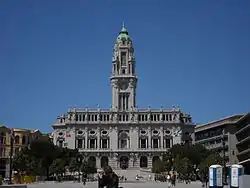Câmara Municipal
A câmara municipal (Portuguese pronunciation: [ˈkɐmɐɾɐ munisiˈpaɫ], meaning literally municipal chamber and often referred to simply as câmara) is a type of municipal governing body, existing in several countries of the Community of Portuguese Language Countries.



In Portugal, Cape Verde, Guinea Bissau and Timor-Leste, a câmara municipal is the executive body of a municipality. In Brazil, it is the legislature of a municipality. São Tome and Príncipe has similar câmaras distritais (district chambers), which are the executive bodies of the districts (municipalities).
In all these countries, the members of a câmara are known as vereadores (aldermen).
Brazil
The Brazilian câmaras municipais have their origin in the municipal administration model inherited from Portugal. However, while the Portuguese câmaras evolved towards becoming executive bodies, in Brazil they evolved towards becoming the legislative bodies of the municipalities. In Brazil, the executive municipal power is vested in the prefeituras municipais (municipal prefectures), each headed by the prefeito (mayor).
Each câmara municipal is composed of a number of elected vereadores.
Portugal
Its members (vereadores, aldermen) are elected by the Hondt method, serve year-round and are paid. The president of a Municipal Chamber is the head of the most-voted list. The Câmara Municipal has an odd number of aldermen (from five to thirteen), determined by the number of registered voters within the municipality, with the exceptions of Lisbon (fixed at 17 aldermen) and Porto (15 aldermen).
Each Municipal Chamber has a council, composed of representatives from a variety of organizations, which serve as a consultative body. .
The term can also refer to the building where the Municipal Chamber offices are located, i.e., the City Hall.
A Câmara municipal is an executive body of a municipal, a level higher than the Junta de freguesia. The legislature equivalent of Câmara municipal is the Assembleia Municipal.
See also
References
- PORTUGAL: a country study, Federal Research Division, Library of Congress; Edited by Eric Solsten (public domain)